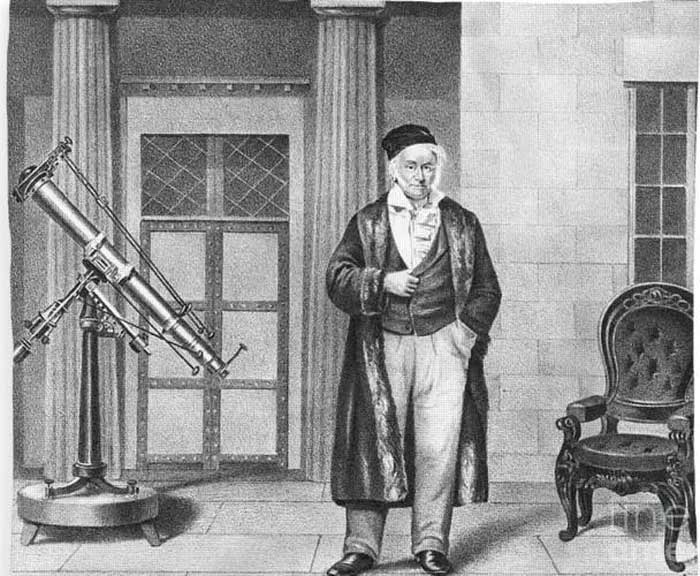At the end of the 19th century and the beginning of the 20th century, with advancements in astronomy, humanity began to look towards neighboring planets and sought ways to prove that we are not alone in the universe.
Among those notable figures was the renowned mathematician Johann Carl Friedrich Gauss, who made efforts to detect extraterrestrial life before the advent of radio signals and space probes.
From Mathematics to Physics and Astronomy
Johann Carl Friedrich Gauss was born in 1777 in Lower Saxony, a region now part of Germany, under impoverished circumstances, with an illiterate mother and a working-class father. However, from a very young age, Gauss showed signs of genius, exhibiting an innate talent for mathematics.
By the age of three, he began to demonstrate extraordinary mathematical abilities. When he entered school at the age of seven, he far surpassed his classmates, and as a teenager, he made groundbreaking discoveries in mathematics, authoring the seminal work Disquisitiones Arithmeticae, which holds a significant place in mathematics and continues to have a profound impact today.
Later, transitioning to the fields of physics and astronomy, he achieved equally impressive successes. Notably, Gauss re-discovered the dwarf planet Ceres, which had been initially discovered by the Italian astronomer Giuseppe Piazzi in 1801 but had lost visibility behind the blinding light of the Sun.
At that time, mathematical methods were insufficient to extrapolate its position from the scant data available. Intrigued by this challenge, Gauss began researching, and within three months, he accurately calculated the position of Ceres, which was subsequently re-discovered by Franz Xaver von Zach that same year.
Thanks to his achievements in astronomy, Gauss became a Professor of Astronomy and the Director of the Göttingen Observatory in 1807. He continued to develop a revolutionary theory on the motion of planets perturbed by larger celestial bodies, publishing it in 1809 in a manuscript titled in Latin, Theoria motus corporum coelestium in sectionibus conicis solem ambientum, which is considered foundational for astronomical calculations ever since.
Searching for Extraterrestrials

Mathematician Johann Carl Friedrich Gauss (1777 – 1855).
Beyond astronomy, planets, and celestial bodies in the universe, Gauss was also deeply interested in extraterrestrial life. Like many scientists of his time, he believed that Mars and the Moon could be inhabited by aliens.
In 1820, he made a decision considered to be humanity’s first effort to communicate with another civilization in the universe, but it was not through radio waves; rather, it was an idea now known as the Pythagorean triangle proposal.
Essentially, it required creating a visual representation of the Pythagorean theorem, including a right triangle with three squares on each side, large enough for someone on Mars or the Moon to see through a telescope.
He envisioned this being accomplished by planting vast wheat fields in a pine forest in Siberia, shaped to form the Pythagorean theorem, with the wheat contrasting against the darker forest surroundings, making it easily visible from space. Gauss believed this would convey to extraterrestrials that we had a fundamental understanding of geometry, as well as capabilities in large-scale agriculture.
Austrian astronomer Johann von Littrow was influenced by this idea, proposing to dig triangular, circular, and square-shaped canal models in the Sahara Desert and then illuminate them with fires at night to communicate with aliens.
Both plans never came to fruition, but Gauss remained steadfast in his ideas. In 1818, he invented a heliograph, which could send messages over long distances by reflecting sunlight.
In 1821, Gauss utilized it and formed another idea for communicating with extraterrestrials, this time using a series of 16 mirrors to send messages to the Moon or Mars, where he believed life existed. Gauss expanded this concept into an even more ambitious project involving 100 linked mirrors, each with an area of 1.5 square meters, capable of sending light to the Moon.
Gauss passed away in 1855, leaving behind an impressive legacy, but his dream of communicating with extraterrestrials remained unfulfilled.
Subsequent Ideas
Gauss’s ideas were revisited in 1874 when the eccentric French inventor Charles Cros proposed that the French government fund a gigantic mirror that would theoretically inscribe messages on the surface of Mars, similar to a giant laser beam. However, this proposal was not accepted. Another Frenchman, A. Mercier, suggested covering the Eiffel Tower with enormous mirrors to send messages to Mars.
The idea of using optical methods to communicate with Martians continued to evolve until it became outdated when Italian inventor Guglielmo Marconi transmitted the first radio message in 1899, heralding the dawn of a new era of human communication.
On November 16, 1974, astronomer Frank Drake sent the first special radio signals to communicate with extraterrestrial civilizations to M-13, a star cluster in the constellation Hercules, from an observatory in Arecibo, Puerto Rico. By this time, the era of gigantic mirrors and physical landscapes for contacting aliens had ended, and a new era had begun.
One day, we will communicate with our neighbors, and at that time, humanity will not forget the original ideas of a renowned mathematician.


















































